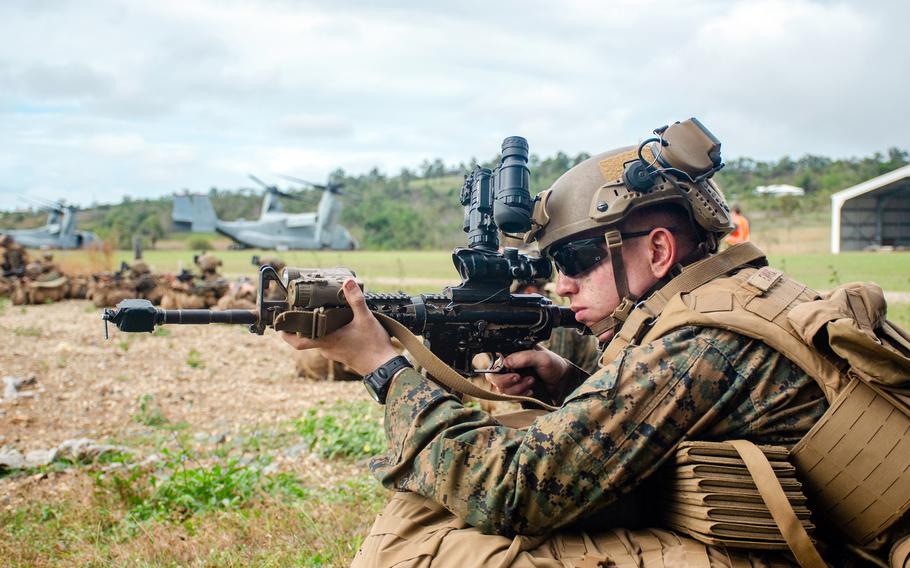
A U.S. Marine posts security during an air-assault exercise at Bloomsbury Airfield in Midge Point, Australia, June 28, 2023. (Stars and Stripes)
Australia should welcome a U.S. Marine Corps rotational force eight times the size of one that now spends six months each year near the northern city of Darwin, a conservative Australian think tank said in a recent report.
“The Australian government should open discussions with the US to host a rotational presence of a Marine Expeditionary Brigade potentially of around 16,000 personnel, bringing with it significant increased firepower and aviation assets,” the Institute of Public Affairs in Melbourne, Australia, recommended in a report released Wednesday.
Marines have been coming to Darwin annually since 2012. This year, 2,000 arrived in the northern Australian port city in March for the rotation.
Meanwhile, Australia and the United States - concerned about China’s rapid military build-up, threat to Taiwan and influence-building efforts in the region - are investing billions to enhance Australia’s northern military bases.
“A larger USMC presence in northern Australia offers the cheapest boost to deterrence Australia could possibly buy,” the Australian report states. “This approach complements the American military strategy of dispersal through the Indo-Pacific and would add substantially to US and Australian capacity to train with and engage the armed forces of neighbouring countries.”
Multiplying the number of Marines in the Northern Territory may require overtures to other states in Southeast Asia, according to the report.
“We think a larger USMC presence would mostly be welcomed,” the report states. “It offers strategic reassurance to our closer South-east Asian neighbours and would be a welcome exercise and training partner.”
The think tank suggested increasing the rotational force between 2025 and 2028.
A larger Marine presence in northern Australia will require a significant expansion in building critical infrastructure in the territory, according to the report.
“We acknowledge that recent governments have started this process, but only stress that more needs to be done more quickly,” the report states. “The government needs to start a discussion with the private sector about the best way to speed and scale-up this exercise.”
Stars and Stripes emailed the U.S. Indo-Pacific Command in Hawaii on Friday seeking comment on the report. In response, the command forwarded the joint statement and fact sheet issued after Defense Secretary Lloyd Austin and Secretary of State Antony Blinken conferred Tuesday in Annapolis, Md., with Australian Deputy Prime Minister, Minister of Defence Richard Marles and Minister of Foreign Affairs Penny Wong.
The documents do not mention a boosted Marine presence but state that the U.S. continues to “conduct more frequent rotational deployments to Australia across air, land, and maritime domains.”
The Northern Territory has plenty of room for more Marines, according to Grant Newsham, a retired Marine colonel and senior researcher with the Japan Forum for Strategic Studies in Tokyo.
“I believe the Marines are indeed looking to deploy more troops to Darwin and Northern Territory — and make more use of the superb training locations, but also the Darwin as a ‘launch point’ of sorts for operations up towards Southeast Asia and beyond,” he said by email Friday.
An expanded housing compound in Darwin was put to work during Pitch Black, a biennial exercise that began July 12 and ended Aug. 2. The exercise brought 4,400 personnel from 21 nations to the Northern Territory and neighboring Queensland.
The Australian military acquired Defence Accommodation Precinct – Darwin last year to house 4,270 Australian and international personnel during the exercise, according to an email Wednesday from Australian Defence Department spokeswoman Kate Hudspith.
“Another 300 members of Marine Rotational Force – Darwin were also housed at DAP-D during the exercise,” the email said.
The precinct, built for natural gas workers over a decade ago, includes air-conditioned rooms, a dining facility, bar, cafe, gym, convenience store, playing field, swimming pool, tennis court, beach volleyball court and indoor basketball court.
The facility means fewer military personnel need to stay in hotels in Darwin during the southern hemisphere’s colder months, which are the Northern Territory’s peak tourism season, the email said.
The compound can accommodate surges of Australian or allied military personnel, according to former Australian assistant defense secretary Ross Babbage.
In an emergency, other mining camp facilities in northern Australia could be pressed into service, he said by email Wednesday.
“Much of this accommodation is readily transportable,” he wrote. “This is, of course, in addition to the larger pool of civilian accommodation available in the Darwin area.”